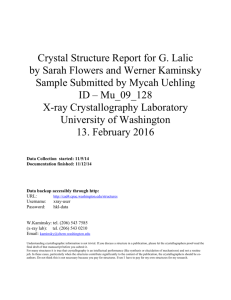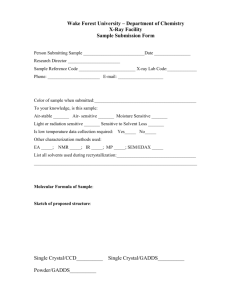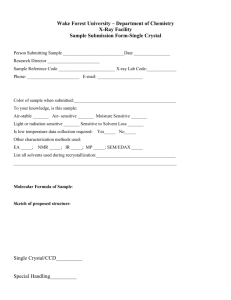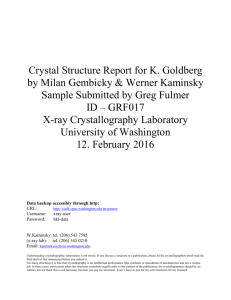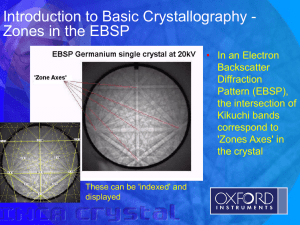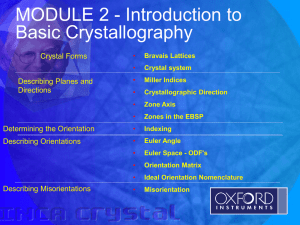Crystal Structure Report for J
advertisement
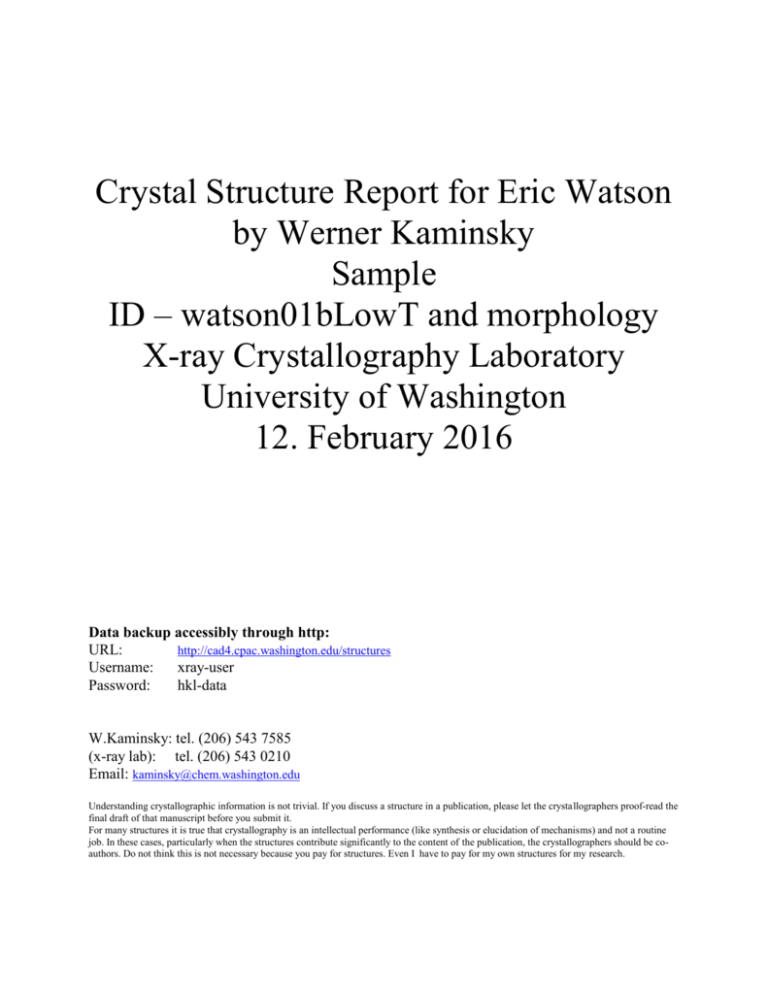
Crystal Structure Report for Eric Watson by Werner Kaminsky Sample ID – watson01bLowT and morphology X-ray Crystallography Laboratory University of Washington 12. February 2016 Data backup accessibly through http: URL: http://cad4.cpac.washington.edu/structures Username: xray-user Password: hkl-data W.Kaminsky: tel. (206) 543 7585 (x-ray lab): tel. (206) 543 0210 Email: kaminsky@chem.washington.edu Understanding crystallographic information is not trivial. If you discuss a structure in a publication, please let the crystallographers proof-read the final draft of that manuscript before you submit it. For many structures it is true that crystallography is an intellectual performance (like synthesis or elucidation of mechanisms) and not a routine job. In these cases, particularly when the structures contribute significantly to the content of the publication, the crystallographers should be coauthors. Do not think this is not necessary because you pay for structures. Even I have to pay for my own structures for my research. A piece of a green prism that chattered into pieces upon cooling, measuring 0.05 x 0.05 x 0.05 mm3 was mounted on a glass capillary with oil. Data was collected at -173oC on a Bruker APEX II single crystal X-ray diffractometer, Mo-radiation. Crystal-to-detector distance was 40 mm and exposure time was 240 seconds per frame for all sets. The scan width was 2o. Data collection was 100% complete to 25o in . A total of 19466 (merged) reflections were collected covering the indices, h = -16 to 16, k = -10 to 10, l = -21 to 21. 1859 reflections were symmetry independent and the Rint = 0.1041 indicated that the data was of slightly less than average quality (0.07). Indexing and unit cell refinement indicated a C centered monoclinic lattice. The space group was found to be C 2/c (No.15). The data was integrated and scaled using SAINT, SADABS within the APEX2 software package by Bruker.1 Solution by direct methods (SHELXS, SIR972) produced a complete heavy atom phasing model consistent with the proposed structure. The structure was completed by difference Fourier synthesis with SHELXL97.3,4 Scattering factors are from Waasmair and Kirfel5. Hydrogen atoms were placed in geometrically idealised positions and constrained to ride on their parent atoms with C---H distances in the range 0.95-1.00 Angstrom. Isotropic thermal parameters Ueq were fixed such that they were 1.2Ueq of their parent atom Ueq for CH's and 1.5Ueq of their parent atom Ueq in case of methyl groups. All non-hydrogen atoms were refined anisotropically by full-matrix least-squares. The BF4- appears disordered. Otherwise the structure is very similar to that at room temperature. The structure is of high quality and ready for publication. Table 1 summarizes the data collection details. Figure 1 shows an ORTEP6 of the asymmetric unit. Figure 1. ORTEP of the structure with thermal ellipsoids at the 50% probability level. Table 1: Crystallographic data for the structures provided. Empirical formula Formula weight Temperature Wavelength Crystal system Space group C18 H26 B F4 Fe 385.05 100(2) K 0.71073 Å Monoclinic C 2/c Unit cell dimensions a = 13.4154(4) Å = 90°. b = 7.9607(4) Å = 108.941(4)°. c = 17.3510(8) Å = 90°. Volume Z 1752.68(13) Å3 4 Density (calculated) 1.459 Mg/m3 Absorption coefficient F(000) 0.896 mm-1 804 Crystal size Theta range for data collection Index ranges Reflections collected Independent reflections Completeness to theta = 25.00° Max. and min. transmission 0.05 x 0.05 x 0.05 mm3 2.48 to 26.82°. -16<=h<=16, -10<=k<=10, -21<=l<=21 19466 1859 [R(int) = 0.1041] 100.0 % 0.9566 and 0.9566 Refinement method Data / restraints / parameters Full-matrix least-squares on F2 1859 / 0 / 124 Goodness-of-fit on F2 Final R indices [I>2sigma(I)] R indices (all data) 1.036 R1 = 0.0406, wR2 = 0.0705 R1 = 0.0797, wR2 = 0.0817 Largest diff. peak and hole 0.361 and -0.401 e.Å-3 Differences between structures The batch contained similar looking green prisms and thin plates. Indexing of 10 samples revealed that the plates and most of the more compact green plates were identical. They indexed at room temperature and 100K in the space group P 21/n with unit cell dimensions (100K, report watson01a) Volume a = 8.2561(3) Å = 90°. b = 8.4486(3) Å = 93.997(2)°. c = 25.6780(9) Å = 90°. 1786.75(11) Å3 For these crystals, ferrocenes are rotated by about 73 degrees towards each other and BF4- appears disordered. One prism however was found which indexed at room temperature and 100K in the space group C 2/c Unit cell dimensions (100K, this report) Volume a = 13.4154(4) Å = 90°. b = 7.9607(4) Å = 108.941(4)°. c = 17.3510(8) Å = 90°. 1752.68(13) Å3 Strikingly, the crystal crumbled upon cooling, likely due to a large change in monoclinic angle of almost 1 degree. For these crystals, ferrocenes are rotated by 180 degrees towards each other, BF4- appears definitely disordered at 100K, however at 100K it was treated with slightly larger than normal thermal ellipsoids (see report: watson01b). Images below (Figure 2) show the indexed (idealized) morphologies (WinXmorph).7 Simulation with the BravaisFriedel; Donnay-Harker model with WinXmorph revealed all indexed faces, but in different order of importance, indicating strong directional bonding characteristics of the structures which in both cases exhibit alternating layers of BF4- and the iron complex. Figure 2. Idealized crystal morphologies of the crystals from which structures were derived. References 1 Bruker (2007) APEX2 (Version 2.1-4), SAINT (version 7.34A), SADABS (version 2007/4), BrukerAXS Inc, Madison, Wisconsin, USA. 2 (a) Altomare A, Burla C, Camalli M, Cascarano L, Giacovazzo C, Guagliardi A, Moliterni AGG, Polidori G, Spagna R. (1999) SIR97: a new tool for crystal structure determination and refinement Journal of Applied Crystallography, 32, 115-119. (b) Altomare A, Cascarano G, Giacovazzo C, Guagliardi A. (1993) Completion and refinement of crystal structures with SIR 92. Journal of Applied Crystallography, 26, 343-350. 3 Sheldrick GM. (1997) SHELXL-97, Program for the Refinement of Crystal Structures. University of Göttingen, Germany. 4 Mackay, S.; Edwards, C.; Henderson, A.; Gilmore, C.; Stewart, N.; Shankland, K.; Donald, A. (1997) MaXus: a computer program for the solution and refinement of crystal structures from diffraction data. University of Glasgow, Scotland,. 5 Waasmaier, D.; Kirfel, A. (1995) New Analytical Scattering Factor Functions for Free Atoms and Ions. Acta Crystallographica A., 51, 416430. 6 Farrugia LJ. (1997) Ortep-3 for Windows. Journal of Applied Crystallography, 30, 565 7 a) W. Kaminsky. (2005) WinXMorph: a computer program to draw crystal morphology, growth sectors and cross-sections with export files in VRML V2.0 utf8-virtual reality format. J Journal of Applied Crystallography, 38 ,566-567. b) W. Kaminsky. (2007) From *.cif to virtual morphology: new aspects of predicting crystal shapes as part of the WinXMorph program. J. Appl. Cryst., 40, 382-385.
